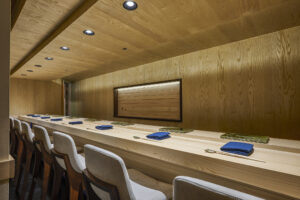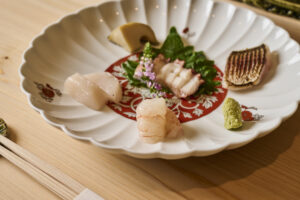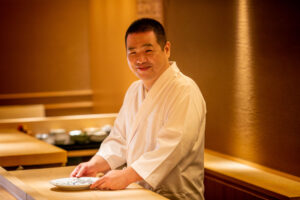At QUEEN Miami Beach you can indulge in the same ultimate immersive dining experience as Will Smith, Jeff Bezos, Dj Khalid, and more! Enjoy the seamless blend of superb Japanese cuisine and world-class hospitality, with today’s bold modernity of elevated nightlife to evoke a new era of posh Miami has yet to see. With renowned architect Carlos Rodriguez of ModPlay Studio at the helm of Queen Miami Beach’s unrivaled design, you will be amazed at the awe-inspiring reimagination of the space.
Food
Looking for something new to do in the D.C area? Look no further because The Navy Yard area just got more and more exciting!
Swingers NoMad Introduces The Famous Emmy Squared Burgers To Their Menu
This award-winning burger can now be enjoyed while you play a round of mini golf
Dukunoo has been participating in Miami Health and Wellness Months from mid-February through the end of March. Come in to Dukunoo and try the healthier side of living by treating yourself and loved ones to their vegetarian, vegan and pescatarian options and much more during the months of February and March. As the saying goes, “Come Fi Di Food, Stay Fi Di Vibes”! The 15% lunch discount runs Tuesday to Friday lasts all the way through the end of March between the hours of 12 noon to 4PM. The delicious offerings include a delectable Beyond Jamaican Jerk Burger, Vegan Ackee rolls and Curry Chickpeas just to name a few.
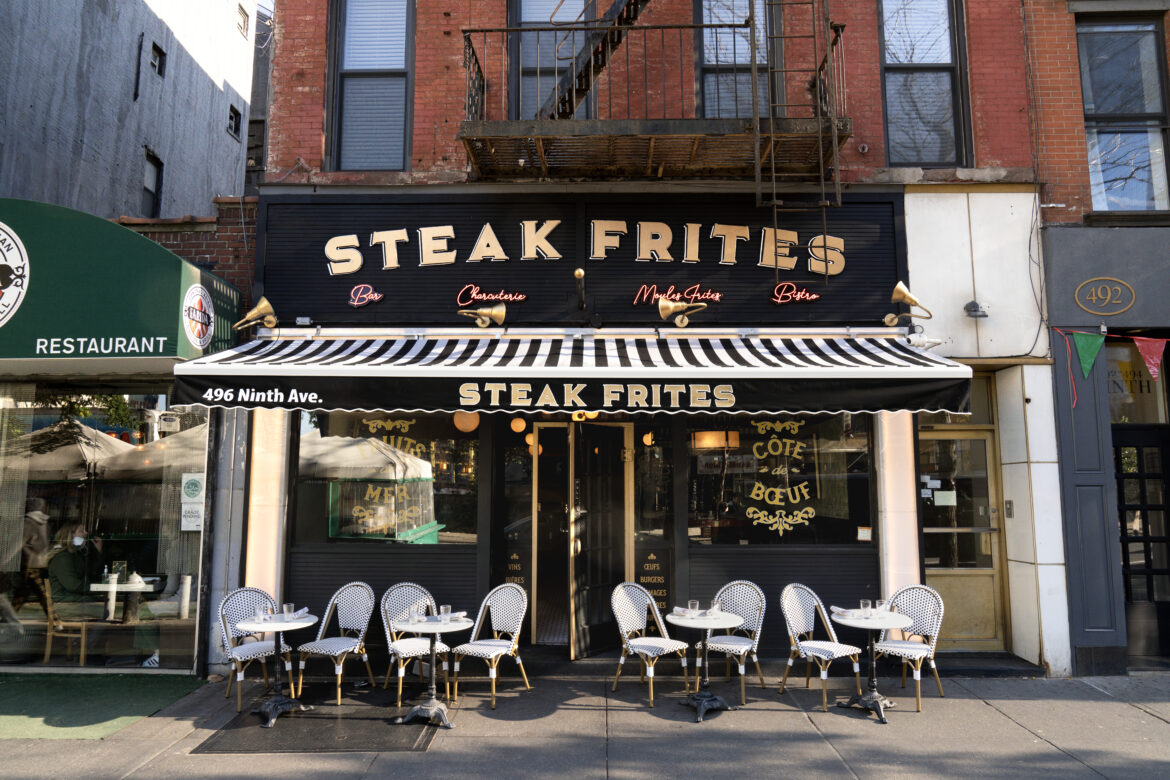




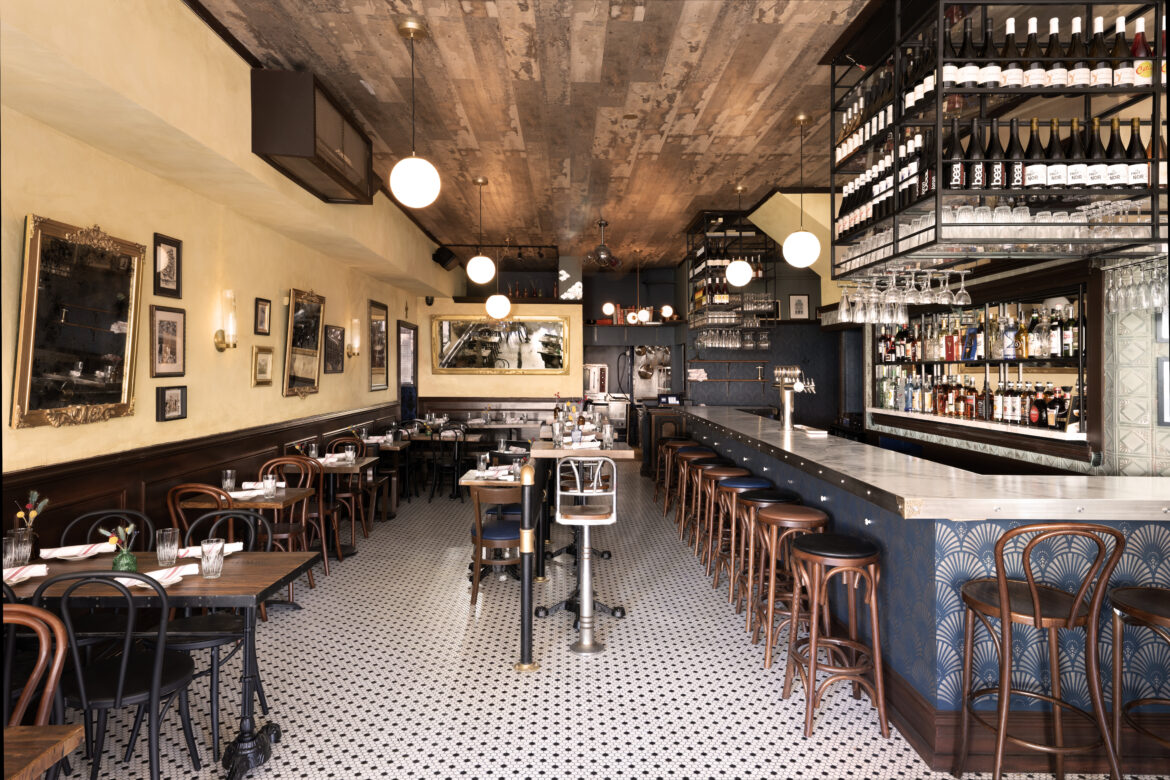


Whether they’re lovers of food, French wine or simply good ambiance, New Yorkers now have a new French restaurant to add to their rolodex: Steak Frites Bistro. Located in Hell’s Kitchen with Parisian decor throughout, even at nine PM on a Wednesday, this bistro is rife with good times and even better food.
Valentine’s Day 2023 Gift Guide














Michelin-Recognized Sweetbriar Launches Tasty Tequila Cocktails for January
This past week, Michelin-recognized restaurant Sweetbriar hosted a special happy hour to celebrate their January partnership with the tequila brand we all know and love, Don Julio.
Earlier this year, we got to check out Plan Do See’s famous Bubusan and Azabu New York. On Saturday, we went back to Azabu for their premier dining experience. The bottom level of the restaurant boasts a world-class Omakase experience: The Den. Nestled into a quiet street in Hudson Square, the New York location of Azabu Sushi draws inspiration from its wildly successful Miami counterpart while bringing in elements of New York charm.
It boasts a new name, new menu, and new space: Azabu New York aims to transport guests to Tokyo’s Azabu neighborhood, known today for its laid-back, chic vibe but originally as a hub for merchants and traders.
The interior of Azabu New York’s space is inspired by Buddhist and Shinto aesthetic qualities, with calming, simple decor, a hidden sliding-door entrance, and Noguchi lamps. Architect Ian Bentley of NOISE was the creative mind behind the new design. The Den emulates Buddhist design and Azabu captures Shinto elements, with its soft blonde wood counters and touches of cobalt blue.
We stopped by their happy hour launch a few months ago to sample some cocktails and excellently crafted nigiri, and learn more about the revamped Azabu’s mission. Sake, white wine, and red wine were served in beautifully designed cups as guests attending the launch settled into the clean, cozy space. We loved that happy hour, and were highly anticipating the opening of The Den, their second concept location of the Michelin-starred omakase speakeasy inside Azabu Miami Beach.
Our meal at The Den was an expertly crafted experience, led by Chef Toshihide Terado, who has over 20 years of culinary experience across the globe. The meal consisted of a series of appetizers, a toro tasting, chef’s choice seasonal nigiri, and finished off with miso soup and dessert. We started off with a carafe of Suijin Junmai sake, which was served in ornamental aluminum cups designed to conduct and maintain the temperature of the drink. It was the refreshing palate cleanser I craved and kept reaching for throughout the meal.
The few courses were a delish spread of crab salad, a mackerel preparation, squid and mantis shrimp. Each was bursting with flavor, both sweet and savory, and watching the careful creation of each dish took eating it to the next level. The nigiri portion of the Omakase began with a toro tasting: Akami (lean tuna), Chu-toro (medium fatty tuna), O-toro (fatty tuna) came out prepared with real wasabi, soy sauce, and sudachi (japanese lime). We had about 4 more pieces of nigiri which all blew me away, but my favorite was the Sanma which is also a type of mackerel. We wrapped up the meal with my favorite course of the night: uni rice topped with salmon roe and more firm uni. Decadent, creamy, and briny, this dish combined two of my favorite seafood items into one delicious flavor profile carried by the rice. After those amazing courses, we had some light and fluffy japanese omlette, comforting miso soup, and finished off the meal with the most juicy melon I’ve ever had.
Eating at The Den is an experience that treats all the senses, and it’s clear to see why the original Miami location earned a Michelin star. I loved all the dishes and the Chef’s explanations, and can’t wait to try more of Azabu New York’s offerings.
On Wednesday, Nov. 30 The Knockturnal was on the scene of Phillip K. Smith III’s Garden of Reflections with food and drinks by Michael Solomonov (Chef and Owner of Zahav, Abe Fisher, Merkaz, Dizengoff, Goldie, Laser Wolf, Federal Donuts and K’Far in Philadelphia, PA and Laser Wolf in Brooklyn, NY).
Solomonov’s delicious Mediterranean inspired spread included Instagram-worthy Ceviche in Bissli Bag, Hummus Cones with Brussel Sprouts & Green Garbanzo, and Mushroom Baklava. Guests also were invited to indulge in an open bar and enjoy handcrafted cocktails, wine, and champagne. American Express cardholders also received a cookbook: Zahav: A World of Israeli Cooking. The cookbook features many Israeli recipes, personal stories, and a dictionary of related terms.
My personal favorite item of the day was the Ceviche in a Bissli Bag. The flavors were outstanding and unique and eating it out of something that resembled a chip bag was so innovative, convenient, and mess-free to eat at this event.
“Food, culture and art are so intricately linked and I am thrilled to be partnering with American Express and Resy to bring this exciting experience to guests in Miami,” said Chef Michael Solomonov, Chef and Owner of Zahav and five-time James Beard Foundation award-winner.
Resy and American Express to Host Multiple Dining Events During Art Week in Miami Including Dinner Series with Massimo Bottura, Missy Robbins and Mashama Bailey with Original Art by Phillip K. Smith III; Gallery Day to Feature Food by Michael Solomonov
The art featured was “Phillip K. Smith III’s Garden of Reflections.”
Garden of Reflections is an installation composed of 17 columnar sculptures that collage the light, atmosphere, and movement of the space across their highly reflective and folded mirror polished steel surfaces. Organically collected in three different groups, the artwork reacts to the immediate surroundings, colors, and realities of the day. As the light of the space changes, so the artwork changes. As people move within the space, the artwork reacts accordingly. This reflective experience reconfigures and compresses directionality and space, amplifying one’s perception of their surroundings. The result is an installation that is equally powerful and quiet, completely immersive, and changing at all times, no matter day or night.
More about the artist: Working in the Southern California desert’s Coachella Valley, Phillip K. Smith III creates light-based work that draws upon ideas of space, form, color, light + shadow, environment, and change. Featured in many online and print publications, Smith is known for creating large scaled temporary installations such as Lucid Stead in Joshua Tree, Reflection Field and Portals at the Coachella Music and Arts Festival, ¼ Mile Arc in Laguna Beach, and The Circle of Land and Sky at inaugural 2017 Desert X exhibition. His public artworks are sited in Los Angeles, San Francisco, Kansas City, Nashville, Oklahoma City and beyond; and the artist was recently commissioned to create permanent, light-based works for the cities of West Hollywood, CA, La Jolla, CA, and Bellevue, WA. The artist currently has solo exhibitions on view at the Scottsdale Museum of Contemporary Art through August 6, 2023, and at the Palm Springs Art Museum through May 7, 2023.
ABOUT GLOBAL DINING ACCESS BY RESY:
Global Dining Access by Resy is a dining program for eligible* American Express Card Members that provides elevated access to top restaurants in the United States and internationally. Card Members can utilize the program’s benefits – to get access for exclusive tables, Priority Notify, event access – by having their eligible American Express Card on file in their Resy profile. In the U.S, Global Dining Access exclusive tables are available at 500+ restaurants including Carbone (NY) Lilia (NY), Via Carota (NY), Zahav (PHL), Monteverde (CHI), Mi Tocaya (CHI), Mother Wolf (LA), Kato (LA), Contessa (MIA), Rose’s Luxury (DC), Sarma (Boston), Carbone Vino (DAL) and more.
Global Dining Access members are also invited to purchase tickets to Global Dining Access events featuring top chefs and restaurants. Past events have included World’s Best Restaurant noma’s 5-day residency in New York City (May 2022) and Platinum Coast (September 2021), a floating restaurant on a barge in Manhattan’s East River featuring Nancy Silverton, Kwame Onwuachhi, Stephanie Izard and more Global Dining Access Chefs.
*Global Dining Access by Resy membership extends to eligible U.S. American Express Cards: Platinum Card®, Business Platinum Card®, Corporate Platinum Card®, The Centurion Card, Centurion Business Card, Delta SkyMiles® Reserve American Express Card, Delta SkyMiles® Reserve Business American Express Card, and Hilton Honors American Express Aspire (see Global Dining Access Terms and Conditions).
Indian Restaurant Utsav Revolutionizes Manhattan’s Indochinese Cuisine Offerings
Indian Decadence
Utsav, a second-floor restaurant located directly opposite the Diamond District, and not far from Times Square, initially gives a quiet impression. There is no corporate overture, no grand entrance, and no boastful accomplishments smeared on the walls, as seen in many of Utsav’s competitors.

Jaison, the General Manager
Instead, a walk past a quaint bar and up a flight of stairs led straight to the lobby of the restaurant; elegant but modest, and not at all overdone. Classic Indian decor lined the walls, adding to the delicate story of the scene without being ostentatious. I was greeted by Jaison, the General Manager, and before long, I was seated at a cordial table with a view gazing up at several towering skyscrapers located right across the street.
Indochinese Refined
At the table, I was given a food and drink menu, and I began examining my options. What delighted me at once was to see carefully denoted vegetarian options, separated from those with meat, which made it easy for me to find what I could eat. Being familiar with Indochinese cuisine, I found some familiar favorites, like Chili Paneer and Hakka Noodles, as well as several new items I had not before encountered, such as Crispy Chili Babycorn. Every item looked deliberately chosen, and nothing seemed in excess or without purpose; in a relatively short Indochinese menu, all bases of the cuisine were covered for any preference. Soon, Nandita Khanna, the owner of the restaurant herself, came to greet me. She was extremely friendly, but also chose her words carefully and seemed to peruse over each sentence before delivery. We discussed the purpose of my visit, and then she began explaining her story.
A History in Fine Dining
Nandita comes from a long line of restaurant owners, in a family where food is a deeply rooted tradition worldwide. Despite her grandfather owning nineteen restaurants in Tokyo, they had had their beginning in Calcutta, India, Nandita’s home city. “Calcutta is the Indochinese center of the world,” she told me. “This is where the best dishes come from.” She explained how Utsav is the only restaurant owned by her family in America, and thus, she has no other members to assist her in its daily operations. “It was tough for the last several years, especially with Covid. We lost a lot of business. I didn’t even have money to pay my landlord sometimes,” she explained grimly. However, unlike many other specialized restaurants that closed during the pandemic, Utsav was able to prosper once more. “It’s rare for a female owner to make it in the restaurant business. We recovered from Covid, but I have not reached my goal yet. There is still more work to be done.”
Appetizers
To begin, Nandita asked me what I had tried previously at other restaurants, and what dishes I preferred. She made recommendations utilizing my responses.

Chili Paneer

Crispy Chili Babycorn
After I told her I am a big fan of paneer, she implored me to try her Chili Paneer. “You’ll also love the Cauliflower Manchurian and the Crispy Chili Babycorn,
I know it’s exactly what you’ll like,” she stated vehemently. Trusting her judgement, I obliged. I appreciated her effort in catering to my preferences, and simultaneously bringing me out of my comfort zone to try something I would have otherwise missed. Nandita also recommended several original cocktails, and I chose to try a turmeric-ginger one, and after assuring her that I could handle the spice, a jalapeño coriander one.

Indian-inspired cocktails
The drinks were delivered to me, and I realized I could not in fact handle the spice. Still, they were light and refreshing, and I welcomed the Indian twist. The appetizers also began to trickle to my table, and I noticed there was special care taken in the presentation—each dish was beautifully lain, with sauces and garnishes perfectly arranged and appealing to the eye. All three plates were great: the babycorn was crispy and perfectly seasoned (I wish it was available at movie theaters), the manchurian’s gravy was succulent, spicy, and thick, and the chili paneer was the highlight, with the paneer cooked to the perfect consistency and the sauce tangy and flavorful. The appetizers left me with anticipation for what could be next.
Entrées
Nandita already had some entrées in mind when she came back to my table. Recognizing that I absolutely loved the paneer appetizer, she suggested I order the Paneer Szechuan for the main course. She also added a Manchurian Vegetable, a Burnt Garlic Coriander Fried Rice, and for something more familiar, a Vegetarian Hakka Noodle. After ordering, I conversed with her further, learning that she would be traveling back to India the very next day. “You picked the perfect day to visit,” she told me. “After today and I would not have been present to serve you.” She explained how she had not been home to India since prior to the pandemic, and she would be going back for the first time in three years. “I do not have any family here, everyone is back in Calcutta.”
My food arrived, and if the appetizers shocked me, the entrées were on a whole different level. Deeply enriched with various spices and sauces, and possessing a definite inspiration from traditional Indian-Chinese cooking, but with a tantalizing modern presentation, each dish was a journey to behold. The aromatic gravy of the Szechuan Paneer, with sautéed onions and peppers mixed in, was unbelievable.

Burnt Garlic Coriander Fried Rice
Not being a fan of rice, I was still unable to help myself to the garlicky pangs of flavor emanating from the coriander rice, and the Hakka noodles and Manchurian left little to be desired. Each plate, carefully crafted with an eye for detail, left me with a different experience; each had a story.
Dessert
For dessert, I was reluctant to try something new. I had ventured into the realm of Indian sweets before, and I had never been impressed; the overly sugary confectionary taste was not for me. Nonetheless, Nandita assured me that her classic Mishti Doi would be perfect for me. She told me it was a Bengali delicacy, and with little other information, I trusted her judgement and ordered it. I also ordered a traditional Ras Malai, an Indian milk-based dessert that I was fond of, as backup.
I was pleasantly surprised by the Mishti Doi. A family recipe, Nandita explained what the name means: mishti is “sweet” in Bengali, and doi was analogous to “dahi”, a word for southeast-asian yogurt. The dish was sweet-yogurt indeed— a creamy, reddish-orange hue curd presented in a chilled clay pot. It was simply delicious, with a lightly sweetened taste that was not at all overbearing. Of course, the Ras Malai was perfect as well.
A Story Through Cuisine
Thoroughly having enjoyed my meal, and bidding Nandita and her servers farewell, I began to reflect on the insight I had gained about the restaurant.

Iconic Decor
Utsav has been open for nearly 23 years, almost a quarter of a century. After it was opened in 2000, it has been giving every restaurant goer a taste of what it means to not only serve good food, but to have a purpose behind the food. Nandita wishes to share her culture and heritage, the very essence of her upbringing in the city of Calcutta, with each of her patrons, and this is clearly evident.
You can see it in the excitement she has when suggesting a dish, or the way her eyes light up when explaining what it consists of. She is a living testimony to presenting food as an art form—a piece only becomes art once there is a story behind it.
I cannot recommend Utsav enough, and I implore anyone that is in the area to visit it at the corner of 6th Ave and W 47th street in Manhattan.






